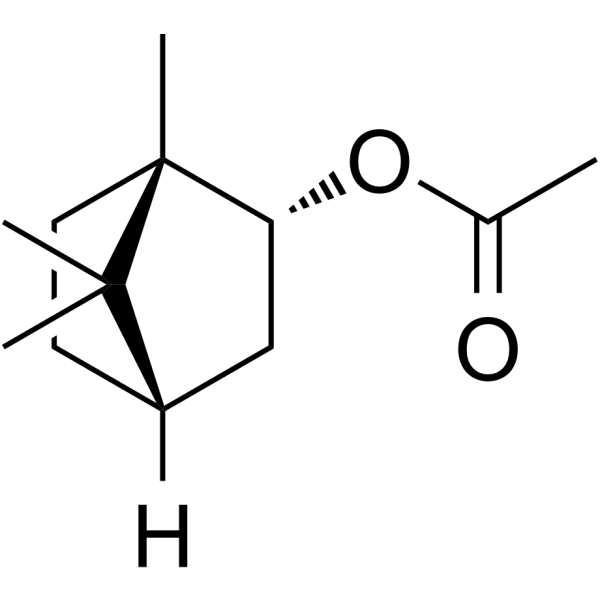
| 规格 | 价格 | 库存 | 数量 |
|---|---|---|---|
| 500mg |
|
||
| 1g |
|
||
| Other Sizes |
| 靶点 |
Human Endogenous Metabolite
|
|---|---|
| 体外研究 (In Vitro) |
与暴露于()-乙酸冰片酯的幼苗相比,前者的波状根有相当大的延长[1]。当单独给予大麦幼苗时,与不含乙醚的对照相比,(-)-乙酸冰片酯(L-乙酸冰片酯)减少了白粉病感染[2]。
|
| 药代性质 (ADME/PK) |
Absorption, Distribution and Excretion
The percutaneous absorptions of camphene, isoborneol-acetate, limonene, menthol and alpha-pinene as constituents of a foam bath (Pinimenthol) were measured on animals using radioactively labelled ingredients. Pharmacokinetic measurements showed maximum blood levels for all tested ingredients 10 min after the onset of percutaneous absorption. None of the ingredients was preferentially absorbed. Blood levels of all ingredients after 10 min of percutaneous absorption were a direct function of the size of the skin area involved. Metabolism / Metabolites Isobornyl acetate readily hydrolyzes (within hours) to isobornyl alcohol during the first step of its biochemical pathway. The alcohol will become conjugated with glucoronic acid and be excreted in the urine (expected within hours to days). |
| 毒性/毒理 (Toxicokinetics/TK) |
Toxicity Summary
IDENTIFICATION AND USE: Isobornyl acetate is used in soaps, detergents, creams and lotions and perfumes. HUMAN STUDIES: A maximization test was carried out on 25 volunteers. The material was tested at a concentration of 10% and produced no sensitization reactions. ANIMAL STUDIES: Isobornyl acetate applied full strength to intact or abraded rabbit skin for 24 hr under occlusion was mildly irritating. Isobornyl acetate was administered daily to rats in doses of 0, 15, 90 or 270 mg/kg bw for 13 wk. Male rats had signs of nephrotoxicity at 90 mg/kg and 270 mg/kg/day, as well as signs of hepatotoxicity at 270 mg/kg. Isobornyl acetate was investigated in a 1-generation reproduction study in rats and it did not produce developmental toxicity. Increased incidences of excess salivation occurred in parent generation male and female rats at 100 and/or 300 mg/kg/d throughout the dosage period, and low incidences of urine-stained abdominal fur were seen in females at 300 mg/kg/d during the gestation period. Non-Human Toxicity Values LD50 Rabbit dermal >20 g/kg LD50 Rats oral >10 g/kg LD50 Mice oral 3100 mg/kg LD50 Rat oral 9050 mg/kg |
| 参考文献 |
|
| 其他信息 |
Bornyl acetate has been reported in Artemisia thuscula, Curcuma xanthorrhiza, and other organisms with data available.
Mechanism of Action A possible explanation for the nephrotoxic effects in males but not females is the accumulation of alpha-2u-globulin, a protein in the male rat kidney that appears to lead to renal tubule tumor formation. |
| 分子式 |
C12H20O2
|
|---|---|
| 分子量 |
196.29
|
| 精确质量 |
196.146
|
| CAS号 |
5655-61-8
|
| 相关CAS号 |
Bornyl acetate;76-49-3;(+)-Bornyl acetate;20347-65-3
|
| PubChem CID |
6448
|
| 外观&性状 |
Colorless to light yellow liquid
|
| 密度 |
1.0±0.1 g/cm3
|
| 沸点 |
223.5±0.0 °C at 760 mmHg
|
| 熔点 |
29ºC
|
| 闪点 |
84.4±0.0 °C
|
| 蒸汽压 |
0.1±0.4 mmHg at 25°C
|
| 折射率 |
1.480
|
| LogP |
3.6
|
| tPSA |
26.3
|
| 氢键供体(HBD)数目 |
0
|
| 氢键受体(HBA)数目 |
2
|
| 可旋转键数目(RBC) |
2
|
| 重原子数目 |
14
|
| 分子复杂度/Complexity |
270
|
| 定义原子立体中心数目 |
0
|
| SMILES |
CC(=O)O[C+]12(C)C(C)(C)CCC(C2)C1
|
| InChi Key |
KGEKLUUHTZCSIP-UHFFFAOYSA-N
|
| InChi Code |
InChI=1S/C12H20O2/c1-8(13)14-10-7-9-5-6-12(10,4)11(9,2)3/h9-10H,5-7H2,1-4H3
|
| 化学名 |
(1,7,7-trimethyl-2-bicyclo[2.2.1]heptanyl) acetate
|
| HS Tariff Code |
2934.99.9001
|
| 存储方式 |
Powder -20°C 3 years 4°C 2 years In solvent -80°C 6 months -20°C 1 month |
| 运输条件 |
Room temperature (This product is stable at ambient temperature for a few days during ordinary shipping and time spent in Customs)
|
| 溶解度 (体外实验) |
DMSO : 100 mg/mL (509.45 mM)
|
|---|---|
| 溶解度 (体内实验) |
配方 1 中的溶解度: ≥ 2.5 mg/mL (12.74 mM) (饱和度未知) in 10% DMSO + 40% PEG300 + 5% Tween80 + 45% Saline (这些助溶剂从左到右依次添加,逐一添加), 澄清溶液。
例如,若需制备1 mL的工作液,可将100 μL 25.0 mg/mL澄清DMSO储备液加入到400 μL PEG300中,混匀;然后向上述溶液中加入50 μL Tween-80,混匀;加入450 μL生理盐水定容至1 mL。 *生理盐水的制备:将 0.9 g 氯化钠溶解在 100 mL ddH₂O中,得到澄清溶液。 配方 2 中的溶解度: 2.5 mg/mL (12.74 mM) in 10% DMSO + 90% (20% SBE-β-CD in Saline) (这些助溶剂从左到右依次添加,逐一添加), 悬浊液; 超声助溶。 例如,若需制备1 mL的工作液,可将 100 μL 25.0 mg/mL澄清DMSO储备液加入900 μL 20% SBE-β-CD生理盐水溶液中,混匀。 *20% SBE-β-CD 生理盐水溶液的制备(4°C,1 周):将 2 g SBE-β-CD 溶解于 10 mL 生理盐水中,得到澄清溶液。 View More
配方 3 中的溶解度: ≥ 2.5 mg/mL (12.74 mM) (饱和度未知) in 10% DMSO + 90% Corn Oil (这些助溶剂从左到右依次添加,逐一添加), 澄清溶液。 1、请先配制澄清的储备液(如:用DMSO配置50 或 100 mg/mL母液(储备液)); 2、取适量母液,按从左到右的顺序依次添加助溶剂,澄清后再加入下一助溶剂。以 下列配方为例说明 (注意此配方只用于说明,并不一定代表此产品 的实际溶解配方): 10% DMSO → 40% PEG300 → 5% Tween-80 → 45% ddH2O (或 saline); 假设最终工作液的体积为 1 mL, 浓度为5 mg/mL: 取 100 μL 50 mg/mL 的澄清 DMSO 储备液加到 400 μL PEG300 中,混合均匀/澄清;向上述体系中加入50 μL Tween-80,混合均匀/澄清;然后继续加入450 μL ddH2O (或 saline)定容至 1 mL; 3、溶剂前显示的百分比是指该溶剂在最终溶液/工作液中的体积所占比例; 4、 如产品在配制过程中出现沉淀/析出,可通过加热(≤50℃)或超声的方式助溶; 5、为保证最佳实验结果,工作液请现配现用! 6、如不确定怎么将母液配置成体内动物实验的工作液,请查看说明书或联系我们; 7、 以上所有助溶剂都可在 Invivochem.cn网站购买。 |
| 制备储备液 | 1 mg | 5 mg | 10 mg | |
| 1 mM | 5.0945 mL | 25.4725 mL | 50.9450 mL | |
| 5 mM | 1.0189 mL | 5.0945 mL | 10.1890 mL | |
| 10 mM | 0.5095 mL | 2.5473 mL | 5.0945 mL |
1、根据实验需要选择合适的溶剂配制储备液 (母液):对于大多数产品,InvivoChem推荐用DMSO配置母液 (比如:5、10、20mM或者10、20、50 mg/mL浓度),个别水溶性高的产品可直接溶于水。产品在DMSO 、水或其他溶剂中的具体溶解度详见上”溶解度 (体外)”部分;
2、如果您找不到您想要的溶解度信息,或者很难将产品溶解在溶液中,请联系我们;
3、建议使用下列计算器进行相关计算(摩尔浓度计算器、稀释计算器、分子量计算器、重组计算器等);
4、母液配好之后,将其分装到常规用量,并储存在-20°C或-80°C,尽量减少反复冻融循环。
计算结果:
工作液浓度: mg/mL;
DMSO母液配制方法: mg 药物溶于 μL DMSO溶液(母液浓度 mg/mL)。如该浓度超过该批次药物DMSO溶解度,请首先与我们联系。
体内配方配制方法:取 μL DMSO母液,加入 μL PEG300,混匀澄清后加入μL Tween 80,混匀澄清后加入 μL ddH2O,混匀澄清。
(1) 请确保溶液澄清之后,再加入下一种溶剂 (助溶剂) 。可利用涡旋、超声或水浴加热等方法助溶;
(2) 一定要按顺序加入溶剂 (助溶剂) 。